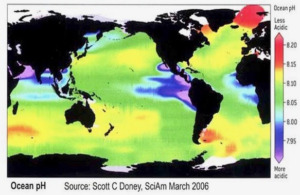by Dr David Whitehouse, June 06, 2016 in GWPF
As far as global temperature goes it’s been a warmish start to the year, though not exceptional. This has led Carbon Brief in its three-monthly “state of the climate” report to predict that this year “is likely” to be as warm as the fourth warmest year since records began about 150 years ago. They say it could be as high as the second or as low as the 12th warmest.
Carbon Brief says, “The first three months of 2018 can give some sense of what to expect for the entire year.” But being based on a quarter of this year’s monthly measurements it could be described as either bold or foolish. Because the prediction is made without a good understanding of what has been happening to the global temperature in the past months it is probably more of the latter.
Nowhere is the Carbon Brief prediction is there any analysis of why 2018 got off to a warm start. Look towards the Tasman Sea that has been adding to global temperatures since late 2017.
The water temperature in the Tasman Sea is well above normal – 6° C more than average for the start of December. New Zealand’s summer was the hottest on record, Tasmania had its hottest November-January on record. It was exceptionally warm on both sides of the Tasman, more than two degrees above average in December and part of January.
(…)
by Ron Cruz, June 5, 2018 in ScienceMatters
Presently sea surface temperatures (SST) are the best available indicator of heat content gained or lost from earth’s climate system. Enthalpy is the thermodynamic term for total heat content in a system, and humidity differences in air parcels affect enthalpy. Measuring water temperature directly avoids distorted impressions from air measurements. In addition, ocean covers 71% of the planet surface and thus dominates surface temperature estimates. Eventually we will likely have reliable means of recording water temperatures at depth.
Recently, Dr. Ole Humlum reported from his research that air temperatures lag 2-3 months behind changes in SST. He also observed that changes in CO2 atmospheric concentrations lag behind SST by 11-12 months. This latter point is addressed in a previous post Who to Blame for Rising CO2?
The May update to HadSST3 will appear later this month, but in the meantime we can look at lower troposphere temperatures (TLT) from UAHv6 which are already posted for May. The temperature record is derived from microwave sounding units (MSU) on board satellites like the one pictured above… (…)

by Prof. Dr. P. Berth, 5 juin 2018, in ScienceClimatEnergie.be
Voici quelques réflexions sur la théorie de l’acidification des océans. Selon cette théorie, le pH des océans diminuerait inlassablement, en raison du CO2 qui ne cesse de s’accumuler dans l’atmosphère.
• Les mesures directes de pH sont récentes et nous n’avons aucun recul. Selon les médias et les ONG écologistes, qui se basent sur le GIEC et sur certaines publications (e.g., Caldeira & Wickett 2003), le pH des océans aurait été de 8.25 en 1750. Cependant, il faut savoir que personne n’a jamais mesuré le pH des océans en 1750, puisque le concept de pH n’a été inventé qu’en 1909 (par le danois Søren P.L. Sørensen), et que les premiers appareils fiables pour mesurer le pH ne sont apparus qu’en 1924… Nous ne sommes donc pas certains de cette valeur de 8.25 pour 1750… La valeur de 8.25 est donc obtenue par des mesures indirectes et n’est donc pas certaine.
• A l’heure d’aujourd’hui, tous les pH sont possibles. Lorsqu’on dit que les océans actuels sont à un pH de 8.1, de quel océan parle-t-on? S’agit-il du pH moyen global? Si c’est de cela qu’on parle, quelle est l’incertitude sur la mesure? (i.e., l’écart-type?). Ceci n’est jamais indiqué. Il faut savoir que si l’on prend un jour de la semaine, tous les pH sont possibles dans les océans, comme l’illustre très bien la figure suivante.

(…)
by David Middleton, June 5, 2018 in WUWT
The Fable of Chicken Little of the Sea
Guest essay by David Middleton,
When if comes to debunking Gorebal Warming, Chicken Little of the Sea (“ocean acidification”) and other Warmunist myths, my favorite starting points are my old college textbooks.
Way back in the Pleistocene (spring semester 1979) in Marine Science I, our professor, Robert Radulski, assigned us The Oceans by Sverdrup (yes, that Sverdrup), Johnson and Fleming. Even though it was published in 1942, it was (and may still be) considered the definitive oceanography textbook. I looked up “ocean acidification” in the index… It wasn’t there.
The notion that CO2 partial pressure influences the pH of seawater isn’t a new concept, *surely* ocean acidification must have been mentioned in at least one of my college textbooks.
(…)
La géologie, une science plus que passionnante … et diverse


